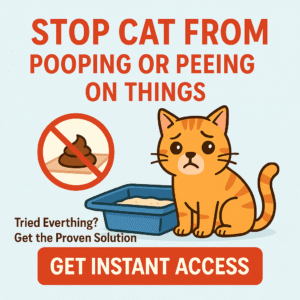Struggling with the stubborn smell of cat urine in your home? You’re not alone—and you’re in the right place. In this article, we’ll share proven, natural remedies to eliminate urine odor using easy-to-find ingredients.
Why Address Cat Urine Smell Naturally?
Many over-the-counter cleaners come with harsh chemicals that can irritate both your cat and your family. Natural alternatives are safer, eco-friendly, and often more effective.
How Acid and Enzymes Work Wonders
Cat urine odor comes from uric acid crystals. Ordinary cleaning often masks odor, while acidic cleaners (like vinegar) break it down—and enzyme-based solutions finish the job by digesting the residue.
Top Natural Remedies to Remove Cat Urine Odor
1. White Vinegar and Baking Soda Solution
This dynamic duo is a favorite among pet parents. The vinegar breaks down the urine’s acid crystals, while baking soda neutralizes odors and absorbs moisture.
- Step 1: Blot the affected area with paper towels to remove excess liquid.
- Step 2: Mix equal parts white vinegar and water in a spray bottle.
- Step 3: Spray generously and let it sit for 10–15 minutes.
- Step 4: Blot dry, then sprinkle baking soda over the spot.
- Step 5: After 30 minutes, vacuum up the baking soda.
Repeat if needed—this remedy works on carpets, hardwood, and upholstery.
2. Lemon Juice and Hydrogen Peroxide Combo
Citric acid in lemon juice and the oxidizing power of hydrogen peroxide make for a potent cleaning pair.
- Step 1: Combine 1 cup hydrogen peroxide, 2 tablespoons lemon juice, and a teaspoon of dish soap.
- Step 2: Spray it on the affected area and let it sit 10–15 minutes.
- Step 3: Blot it up and rinse lightly with water.
- Step 4: Blot again and allow it to air dry.
This method is safe for most surfaces, but always spot-test first.
3. Homemade Enzyme Cleaner
Enzymes are key to breaking down the uric acid that traditional cleaners leave behind. Here’s a simple DIY option:
- In a quart jar, mix: 1 cup warm water, 2 tablespoons brown sugar, 1 tablespoon white vinegar, 1–2 tablespoons dish soap.
- Screw the lid on and shake well.
- Since soap can reduce enzyme effectiveness, don’t add it until just before use.
- Apply before bed, leave overnight, and blot in the morning.
This can be refreshed weekly and stored for several weeks.
4. Activated Charcoal Boost
Use this in tandem with the baking soda method. After treating the area, place an open bowl of activated charcoal to adsorb any lingering odors.
- Replace charcoal every 1–2 weeks.
- Works well for furniture, closets, and vehicles.
5. Essential Oil Air Freshening Spray
While this doesn’t remove the urine itself, it helps freshen the environment safely.
- Mix 1 cup water, 1 tablespoon vodka, 10 drops lavender essential oil, 5 drops eucalyptus oil in a spray bottle.
- Lightly mist carpet or room—avoid directly spraying your cat’s items.
Test on a hidden area first to ensure no discoloration.
Step-by-Step Guide: Cleaning Specific Surfaces
Carpet and Rugs
Carpets absorb urine deeply, and many store-bought sprays only address odors on the surface.
- Blot as much urine as possible.
- Apply the vinegar solution, blot, then follow with enzyme cleaner.
- Cover with baking soda, let sit for a few hours, then vacuum.
- If needed, steam clean the area using water + enzyme solution.
Hardwood Floors
Liquid cleaners can damage wood, so take care:
- Wipe up fresh spots immediately.
- Use a damp cloth with vinegar-water to clean, then dry thoroughly.
- You can follow up with light sanding and finish refinishing if discoloration persists.
Concrete and Outdoor Areas
Fresh spots can be rinsed with water. For older stains:
- Apply undiluted white vinegar, let sit 10 minutes.
- Scrub with a stiff bristle brush.
- Rinse with water.
Preventing Future Accidents
The best remedy is prevention. These strategies help reduce reoffending:
- Clean litter box daily: Fresh litter encourages proper use.
- Use multiple boxes: One per cat plus one extra is ideal.
- Locate boxes privately: Avoid loud, cluttered areas.
- Use enzymatic cleaners quickly: A clean scent discourages repeat marking.
- Address stress: Boredom, household changes, or illness can cause marking. Provide play, routine, and vet care.
When You Need Expert Help
If your cat continues to spray despite cleaning and prevention, it’s time for professional advice. Persistent indoor marking may signal a urinary health issue or stress. Consult your vet—and keep records of frequency, location, and any behavior changes.
Want to Eliminate Cat Spray for Good?
Ready to deep-dive into proven solutions that actually work? Check out Cat Spray No More, the comprehensive eBook packed with step‑by‑step strategies to stop your cat’s spraying behavior—for good.
Download Cat Spray No More now and reclaim your fresh, clean home!
- Understand the why behind your cat’s behavior.
- Implement simple, effective training techniques.
- Discover how to restore litter box habits naturally.
- Equip yourself with a ready‑to‑use strategy so you can enjoy life odor‑free.
Don’t wait—your clean, stress‑free home awaits!
Real-Life Success Story
“After trying spray after spray, I felt defeated—until I applied the vinegar + baking soda trick, then followed the ebook’s advice. Within two weeks, the odor was gone and Fluffy was back to normal in her litter box!”
— Marissa, cat mom of three
Final Thoughts
Tackling cat urine odor naturally is all about smart cleaning, enzyme power, and consistent habits. With these tips—and the guidance of Cat Spray No More—you’ll win the fight against odor and reclaim your peace of mind.
Take Action Today
Now that you’ve got the tools, try one of the natural methods tonight. And don’t forget to grab your copy of Cat Spray No More for all‑in‑one solutions that last.
Related Articles to Explore
- How enzyme cleaners outperform ordinary cleaners
- Top 5 indoor cat stress-relief solutions
- Best household products to help litter box transition
